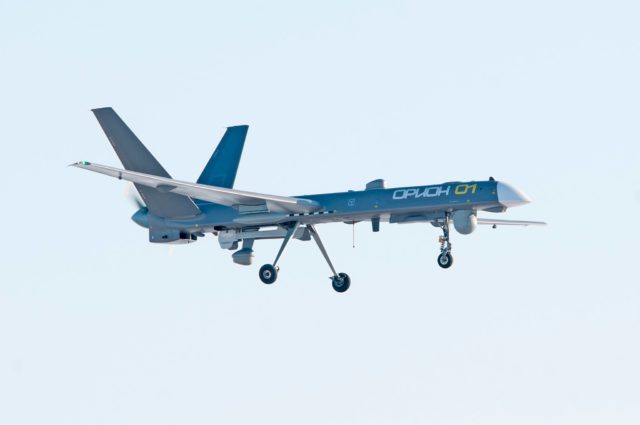
Russia’s Armed Forces Test UAV Capabilities in Tsentr 2019
Publication: Eurasia Daily Monitor Volume: 16 Issue: 127
By:

The Russian Armed Forces tested a broad range of military capabilities during the annual strategic–operational exercise, Tsentr 2019, designated as a strategic command-staff exercise (strategicheskiye komandno-shtabnyye ucheniya—SKShU). Tsentr 2019, being held between September 16 and 21, mainly focuses on the Central Military District (MD) though other MDs are involved, and Russia is joined by forces from Kazakhstan, Kyrgyzstan, Tajikistan, Uzbekistan, China, India and Pakistan (see EDM, September11). As the highlight of this combat training year, Tsentr 2019 is designed to test a variety of approaches to modern warfare, with emphasis on integrating groups of forces, strategic mobility, countering enemy air attacks, as well as rehearsing counter-offensive operations. In the early stages of the exercise, commanders tested the use of unmanned aerial vehicles (UAV) in different conditions (VPK, September 17).
The UAV usage included training their operators to function in smoky conditions wearing gas masks. The overall scheme for testing UAV capabilities drew upon lessons learned from Russia’s involvement in military operations in Syria and other features of the conflict there. Recent tests of Russia’s UAV capability have included the heavy strike UAVs Okhotnik and Altius-U. UAV operators were also used for monitoring purposes during the summer forest fires in Krasnoyarsk, where they had to function in smoke–filled areas with reduced visibility. All the UAV units in the Central MD were involved in Tsentr 2019 using the combined-arms training ranges across the MD. Russian commanders have explicitly noted the expanded role of UAVs in modern conflict, and their involvement in a wide range of conflict settings (VPK, September 17).
Lieutenant Colonel Roman Medvedev, the head of the unmanned aircraft service of the headquarters of the Central MD explained, “UAV means are one of the main types of combat support for troops today. Judge for yourself: these are groups of tasks for conducting air reconnaissance, identifying the forces of a potential enemy in given territories, broadcasting target designations for making decisions on the destruction of identified targets, [and] monitoring the results of the combat operation of ground-based weapons.” These assets are used to aid the process of integrating ground forces and other supporting units as well as to anticipate the actions of the hypothetical enemy (VPK, September 17).
In addition to testing UAV capabilities, there was also increased emphasis on air defense to counter enemy air attacks using UAVs and cruise missiles. The exercise featured S-400 and S-300 surface-to-air missile systems (SAM) as well as the Pantsir-S1, which is designed in part for anti-cruise missile defense (Rossyiskaya Gazeta, September 16). Tsentr 2019 also rehearsed conducting operations in an electronic warfare (EW) hostile environment, with the use of EW against the notional enemy and implementing EW countermeasures (Krasnaya Zvezda, September 16). The strategic–level exercise is occurring simultaneously at training ranges across the Central MD, also utilizing a group of forces in the Southern MD (including the Caspian Flotilla), and at facilities in Kazakhstan, Kyrgyzstan and Tajikistan.
Officially, the exercise scenario for Tsentr 2019 is focused on counter-terrorism. A notional state has formed south of Russia’s borders, involving around 10,000 Islamic militants. Some Russian commentators have linked this aspect of the exercise scenario to the conflict in Syria; they, therefore, argue that a resurgent Islamic State may be factored into the exercise. However, the exercise began with defensive measures against an enemy air attack using UAVs and cruise missiles. According to Lieutenant General Yuri Grekhov, speaking on the first day of the exercise, “Today, according to the scenario, the enemy struck a sudden blow, and used both cruise and ballistic missiles, with the support of small-sized targets—unmanned aerial vehicles carrying weapons. By means of air defense and missile defense of the Russian military space forces, targets were timely discovered and destroyed” (Lenta.ru, September 17).
Tsentr 2019 rehearsed operations in an EW environment and also witnessed water crossings and costal landings along with the coordinated use of high-precision strike systems (Lenta.ru, VPK, September 17). While there was no doubt that a counter-terrorist dimension featured as part of the scenario, it appears that the Russian General Staff modeled different forms of warfare from counter-terrorist operations up to large-scale force-on-force interstate conflict.
As noted, Tsentr 2019 also extended to the Southern MD with the formation of a group of forces centering on Dagestan; this force grouping included air, land and sea elements. The Caspian Flotilla functions as the maritime component of Southern MD. During Tsentr 2019 the Flotilla rehearsed high-precision strikes against the hypothetical adversary. The Caspian marine corps also practiced landings with the aim of seizing a bridgehead and break through to the Kapiysk–Manaskent federal highway. Close air support was provided during these operations, along with anti-aircraft artillery and a fighter unit employing active measures against enemy EW and combat UAVs (Krasnaya Zvezda, September 16).
While Moscow will play up the multilateral dimension of the exercise, Tsentr 2019 remains the culmination of the combat training year and, as such, affords insights into the type of conflicts the General Staff see likely. Some aspects of the exercise imply combat up to the level of large-scale conventional interstate war—though wrapped up in the officially counter-terrorist-based scenario. Still unclear are what roles were offered to the exercise partner militaries as well as the extent to which progress is being made toward achieving interoperability with such forces.



